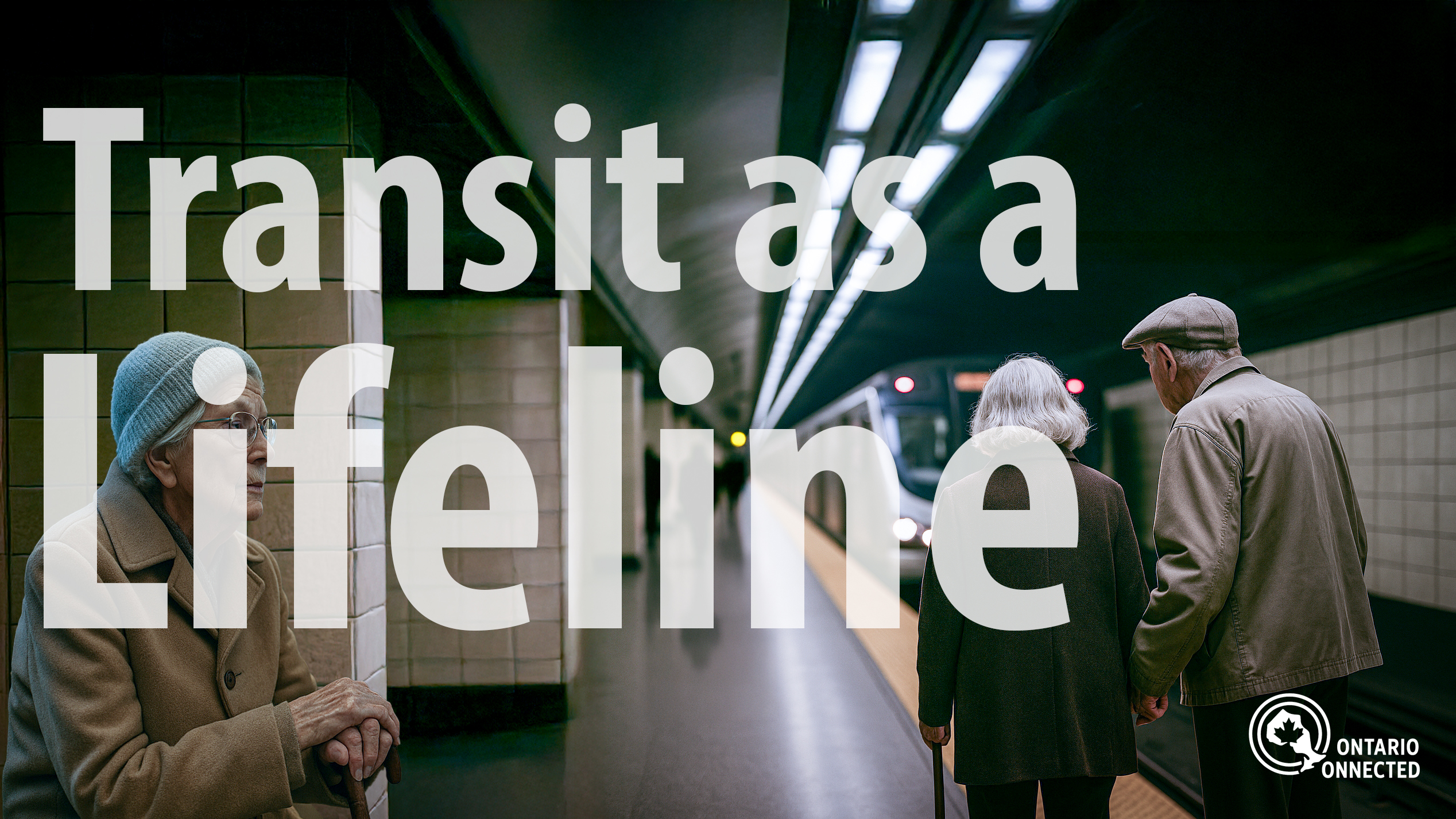Introduction
Ontario’s population is aging quickly. By 2041, nearly one in four residents will be over the age of 65. For seniors, mobility is about much more than simply getting from one place to another. It is about dignity, independence, and maintaining a connection to family, friends, and community. Yet in many smaller towns and suburban areas across Ontario, the lack of reliable transit means seniors are left isolated, vulnerable, and often forced to give up parts of their lives they value most.
Key Takeaway: Reliable transit is about dignity and independence, not just travel.
The Challenge Seniors Face
In communities like Peterborough, Niagara, and Simcoe, transit is often infrequent or unavailable. For seniors who can no longer drive, losing a license often feels like losing their independence entirely. Without a way to get around, simple activities—like meeting a friend for coffee, attending a church service, or volunteering—become daunting challenges.
The emotional toll of isolation is just as heavy as the logistical one. Studies link senior loneliness to higher rates of hospitalization, depression, and even premature death. Without reliable transit, many Ontario seniors are being left behind.
Key Takeaway: A lack of transit leaves seniors socially and emotionally isolated.
Health and Essential Services
Healthcare is another major barrier. Many specialists are concentrated in larger cities, requiring long trips that are impossible without transit. Dialysis appointments, cancer treatments, or even a follow-up with a physiotherapist can be missed simply because there is no bus or train available.
Even daily essentials become a burden. Grocery stores, pharmacies, and banks are rarely within walking distance in suburban neighborhoods. Seniors who cannot travel independently often find themselves skipping meals, running out of medication, or depending entirely on family for basic errands.
Key Takeaway: Missing transit often means missing healthcare, food, and essentials.
Wheel-Trans and Specialized Transit Today
In Toronto, the TTC’s Wheel-Trans program provides a crucial lifeline. Before the pandemic, it carried nearly four million trips annually, offering door-to-door service for riders with disabilities and seniors who cannot use the conventional system.
But the reliance on Wheel-Trans reveals a bigger truth: Ontario’s mainstream transit is not yet accessible enough. Specialized services are meant to fill the gaps—but those gaps remain far too wide.
Key Takeaway: Wheel-Trans fills gaps, but it also shows where regular transit fails.
Could a Connected System Replace Wheel-Trans?
Imagine an Ontario where every bus, train, and station is designed for accessibility from the ground up: step-free entries, reliable elevators, ramps, clear signage, and frequent service. In such a system, many seniors could travel freely without depending on specialized services.
But the reality is that not every senior can make that transition. Those with advanced mobility issues, visual impairments, or cognitive challenges will always need some form of door-to-door assistance. The future isn’t about eliminating Wheel-Trans—it’s about integrating it more intelligently. Seniors who can travel independently should be empowered to do so, while specialized transit focuses on those who need it most.
Key Takeaway: A better system reduces reliance on Wheel-Trans but doesn’t erase the need.
Learning from Airports: Conveyors in Future Hubs
Major international airports have already solved part of this problem. At Toronto Pearson, Amsterdam Schiphol, Singapore Changi, or Dubai International, moving walkways carry millions of passengers across vast terminals every year. Seniors and travelers with limited mobility benefit the most, gliding through long corridors without exhaustion or dependence on staff assistance.
Ontario could apply the same thinking to its future transit hubs. Picture Toronto Union Station redesigned as a true high-speed rail hub: seniors step off a TTC subway, and a moving walkway carries them effortlessly to their GO or HSR platform. In Niagara, Hamilton, or Ottawa, walkways could connect bus depots, retail areas, and HSR stations, reducing fatigue and restoring independence.
By combining moving walkways with elevators, ramps, and plenty of seating, Ontario could set a new global standard for accessibility. Even Wheel-Trans could evolve: instead of navigating deep into stations, vehicles could drop passengers at hub entrances, where moving walkways guide them the rest of the way. Seniors would gain independence while specialized transit becomes more efficient.
Key Takeaway: Airports prove that moving walkways can make huge hubs senior-friendly.
Why Transit is a Lifeline
For seniors, transit is not about convenience. It is about being able to live a full life. Reliable transit allows them to shop, attend social events, see loved ones, and remain active in their communities. It supports “aging in place,” where seniors can stay in their homes longer instead of moving prematurely into assisted living facilities.
Every bus ride, every train journey, every moving walkway is more than just a trip—it is a thread connecting seniors to the world around them.
Key Takeaway: Transit keeps seniors active, connected, and able to age in place.
Solutions and Policy Opportunities
Ontario has choices to make. Expanding regional transit would link smaller towns more effectively into the GO and high-speed rail grid. On-demand microtransit could fill the gaps where fixed routes are not feasible. Subsidized or even free fares would encourage seniors to ride, and universal accessibility must be built into every project—not as an afterthought, but as a baseline.
Hospitals and healthcare providers could partner with transit agencies to ensure seniors never miss an appointment. Volunteer driver programs and shuttles could be tied into transit hubs. The technology and solutions exist—it is the willpower and funding that remain in question.
Key Takeaway: Policy and design decisions today will decide seniors’ mobility tomorrow.
Conclusion
For Ontario’s seniors, transit is not just about mobility—it is about dignity, independence, and health. A connected, accessible system could give most seniors the freedom to travel confidently without relying entirely on specialized services.
Wheel-Trans will always have a role, but with airport-style accessibility features like conveyors, ramps, and seamless transfers, Ontario can build a future where seniors feel included, respected, and empowered.
Transit built for speed is good. Transit built for inclusion is transformative.
Key Takeaway: The future of transit must be designed for both speed and inclusion.



Leave A Comment
You must be logged in to post a comment.